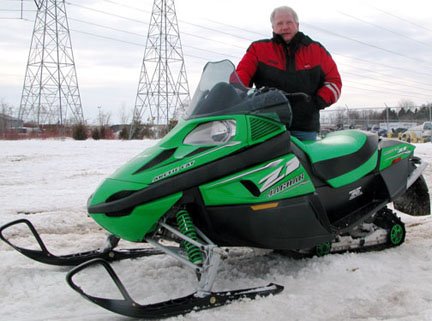With Hardcover History Of Its Sled Story
 Wow! Who would have thought that Yamaha has been a part of snowmobiling for the past four decades? Seems like only yesterday that Yamaha brought high-quality, low-buck sleds to the Americas. Guess that’s how it seems when you get to be a member of the AARP-generation.
Wow! Who would have thought that Yamaha has been a part of snowmobiling for the past four decades? Seems like only yesterday that Yamaha brought high-quality, low-buck sleds to the Americas. Guess that’s how it seems when you get to be a member of the AARP-generation. With its very first model, Yamaha pioneered oil-injection as standard equipment and showed that technological relevance would be a keystone to its future. While that feature eliminated the need to mix oil and gas when refueling your sled, it was a feature that was a bit slow to catch on with the other sled makers. Now, of course, you don’t have to worry about pre-mixing oil to gas with a Yamaha. You should, however, still occasionally check the oil on a modern day 4stroke Yamaha before heading out for a day’s ride.

This new book covers Yamaha’s 40-years in snow-biz from the 1968 SL350 to the 2008 Nytro. In between those two models you’ll discover facts and figures about many of Yamaha’s interesting and historic snowmobiles—such as the unique SnoScoot, the all-conquering Phazer which helped propel Yamaha to #1 in sled sales, and the small displacement World’s Championship Yamaha racing machines that defeated the vaunted Ski-Doo racers.
 If you are “into” Yamaha or vintage snowmobiling, this is a book that you will want in your collection—alongside Jerry Bassett’s Polaris Pioneers and CJ Ramstad’s Legend history of Arctic Cat. The new Yamaha anniversary edition contains rare photos and insights from the early years of Yamaha’s snowmobile development, including an account of the company’s entry into the budding snowmobile market in the late 1960s by one of the project engineers on that team.
If you are “into” Yamaha or vintage snowmobiling, this is a book that you will want in your collection—alongside Jerry Bassett’s Polaris Pioneers and CJ Ramstad’s Legend history of Arctic Cat. The new Yamaha anniversary edition contains rare photos and insights from the early years of Yamaha’s snowmobile development, including an account of the company’s entry into the budding snowmobile market in the late 1960s by one of the project engineers on that team.In this collector’s edition you will find color images of dealership displays, consumer brochures, magazine ads, clothing and accessories from the past four decades. This 96-page volume provides in-depth information on 40 years’ worth of industry-changing snowmobiles. The commemorative book features an embossed dust sleeve as well as an embossed hard cover.
To get a copy of this book, check with your local Yamaha snowmobile dealer or order it on line at: www.toizrit.com/yamahabook.htm.
© 2007 Snowmobilia/Jerry Bassett
To comment go to – http://www.amsnow.com/jerrysblog




































